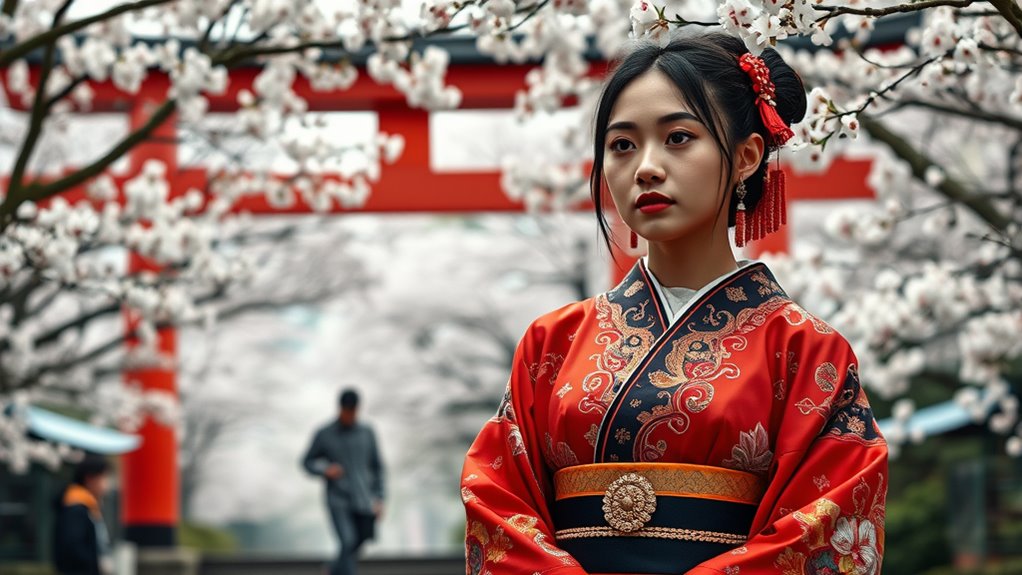Cultural appreciation involves genuinely respecting and understanding the significance of styles or symbols from other cultures, while cultural appropriation occurs when you adopt these elements without regard for their meaning, often trivializing or misusing them. To honor traditions, seek education, support authentic sources, and be mindful of context. If you want to learn how to navigate these boundaries thoughtfully and celebrate cultures respectfully, exploring further can help you make meaningful choices.
Key Takeaways
- Cultural appreciation involves respectful understanding and acknowledgment of a culture’s significance, while appropriation disconnects symbols from their meaning.
- Respectful style choices honor the origins and context of cultural elements, avoiding trivialization or stereotypes.
- Appropriation often commodifies or misuses cultural symbols without consent, risking offense and reinforcing stereotypes.
- Genuine appreciation includes learning about a culture’s history, supporting authentic sources, and engaging with communities.
- Mindfulness and intent are key; celebrating cultures thoughtfully fosters respect rather than superficial trend-chasing.

Have you ever wondered where to draw the line between appreciating and appropriating a culture through fashion? It’s a question many of us grapple with as we explore different styles and trends inspired by diverse cultures. The key lies in understanding the difference between cultural respect and crossing the boundaries of fashion boundaries. When you approach cultural elements with genuine respect, you’re honoring their significance rather than reducing them to mere aesthetic accessories. Recognizing the history, symbolism, and context behind certain clothing or accessories is essential. For example, wearing a traditional headdress without understanding its cultural importance can be seen as disrespectful. Instead, if you’re genuinely interested and show appreciation, you’ll seek to educate yourself and avoid trivializing these symbols. Incorporating wall organization systems thoughtfully can also serve as a metaphor for how we organize and balance cultural influences with respect. Fashion boundaries are often blurred when trends popularize cultural items without acknowledgment or understanding. It’s tempting to adopt styles because they look appealing or trendy, but doing so without awareness can lead to cultural appropriation. Cultural appropriation occurs when someone from outside a culture adopts elements without respecting their origins, often stripping them of their meaning or using them insensitively. This can perpetuate stereotypes or reinforce power imbalances, especially when cultural symbols are commercialized or used as costume-like accessories. To respect cultural boundaries, you need to be mindful of the context and the community behind the style. Ask yourself: Am I using this item to honor its origins, or am I just chasing a fleeting trend? Is my choice informed or superficial? Supporting authentic sources and artisans rather than mass-market imitations can help foster genuine appreciation. Educate yourself about the cultural significance behind specific patterns, fabrics, or styles, and consider whether your use contributes positively or perpetuates misrepresentation. Engaging with communities and listening to their perspectives can also deepen your understanding. When you approach fashion with cultural respect, you’re not only avoiding appropriation but also fostering genuine appreciation. Remember, boundaries aren’t about strict restrictions; they’re about being considerate and mindful of the cultural stories behind what you wear. Ultimately, respecting these boundaries shows that you value the culture’s integrity and want to celebrate it thoughtfully rather than exploit it for personal style.
Frequently Asked Questions
How Can Brands Respectfully Incorporate Cultural Elements Into Their Products?
You can respectfully incorporate cultural elements by practicing cultural sensitivity and seeking ethical collaboration. Research the significance of the elements, engage with community members, and understand their perspectives. Partner with artisans or cultural organizations to guarantee authentic representation. Avoid stereotypes or commodification, and give proper credit. This approach ensures your products honor the culture, fosters genuine appreciation, and builds trust with the community, demonstrating your commitment to respectful and ethical practices.
What Are the Legal Implications of Cultural Appropriation in Fashion?
You could face legal issues if your fashion designs infringe on intellectual property rights, like trademarks or copyrights. If you copy or imitate protected cultural symbols or designs without permission, you risk trademark infringement claims or copyright violations. To avoid these legal pitfalls, guarantee you respect cultural symbols’ originality and seek permission or collaborate with cultural creators. Failing to do so can lead to costly lawsuits and damage your brand’s reputation.
How Do Cultural Exchanges Differ From Cultural Appropriation?
Cultural exchanges are like a generous handshake, fostering mutual respect and understanding, whereas cultural appropriation is a sneaky theft of identity. You can tell the difference through cultural sensitivity and ethical collaboration—when you genuinely honor traditions and include community voices, it’s an exchange. But if you take without understanding, it’s appropriation. So, aim for collaboration that celebrates and respects, not exploits or misrepresents.
Can Cultural Appreciation Be Harmful Despite Good Intentions?
Yes, cultural appreciation can be harmful despite your good intentions. You might mean well, but if you overlook intent versus impact and ignore power dynamics, your actions could reinforce stereotypes or disrespect traditions. It’s important to recognize that even well-meaning gestures can unintentionally perpetuate inequality or cultural insensitivity. Be mindful of how your actions affect others, and always prioritize respectful engagement over superficial admiration.
What Role Does Historical Context Play in Understanding Cultural Appropriation?
Historical context plays a vital role in understanding cultural appropriation because it highlights the historical significance and power dynamics involved. When you consider contextual sensitivity, you recognize how certain symbols or practices carry deep meaning for a community. Without this awareness, you risk dismissing their significance or perpetuating stereotypes. Understanding history helps you approach cultural elements respectfully, appreciating their true significance rather than exploiting them for fashion or trend.
Conclusion
So, next time you choose to embrace a style inspired by another culture, ask yourself: are you genuinely appreciating its significance or unintentionally appropriating it? Respecting origins and understanding meaning can transform your fashion choices from superficial trends into meaningful expressions. Don’t let ignorance overshadow appreciation. Are you willing to celebrate diversity thoughtfully, or will you risk disrespecting the cultures that inspire you? Ultimately, your awareness makes all the difference in choosing respect over appropriation.










